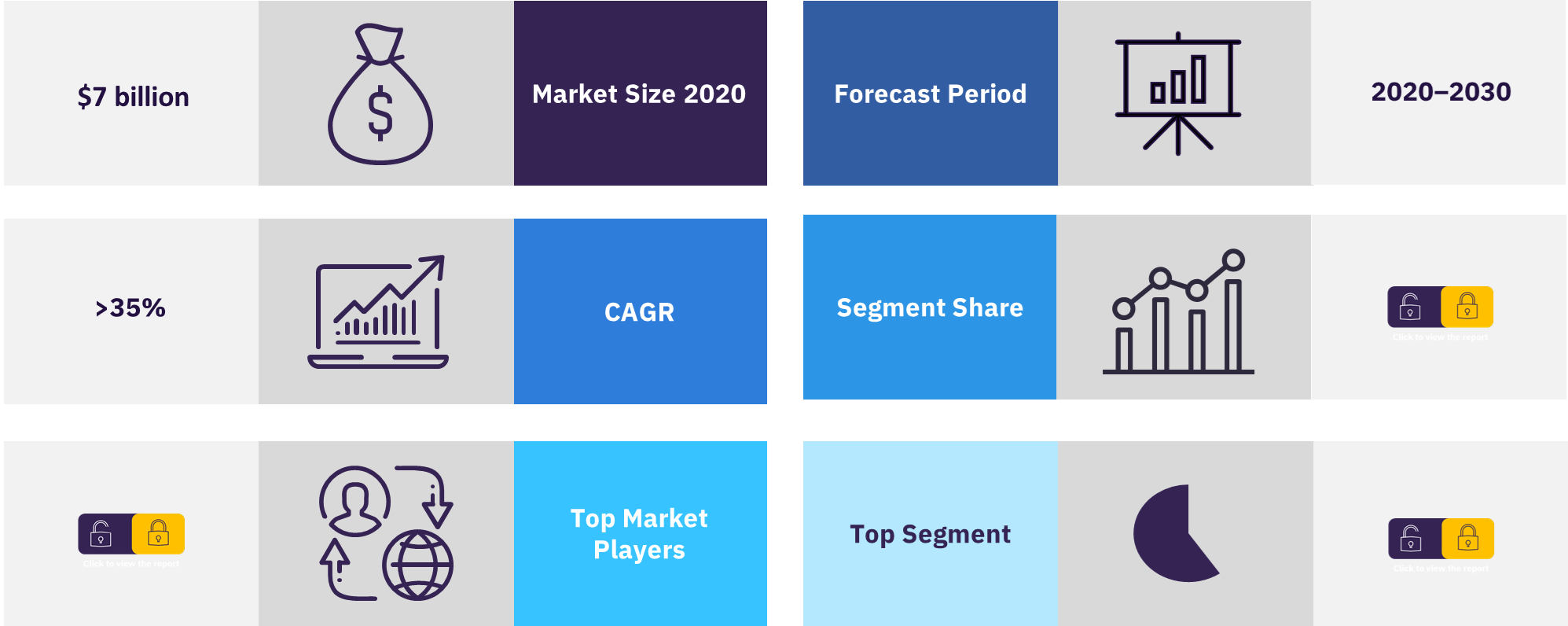Augmented Reality (AR) in Foodservice – Thematic Research
Powered by ![]()
All the vital news, analysis, and commentary curated by our industry experts.
The global Augmented Reality (AR) market was worth nearly $7 billion in 2020. The market is expected to grow at a CAGR of more than 35% during the forecast period. AR is a technology that allows the user to see the real world overlaid with digital data. Furthermore, AR technology will be most valuable to foodservice companies in its capacity to drive consumer purchases and improve operational efficiency.
Adoption of AR for use in the workplace has been slow across the foodservice industry. The few use cases existing are primarily for remote collaboration, spurred on by COVID-19 restrictions and the changing nature of working practices. AR devices can also be used for independent training, inventory management, and improving health and safety standards in food preparation. Foodservice companies deploying these solutions will see greater operational efficiency and improved profit margins.
Global AR market overview
For more insights on this report, download a free report sample
What is the impact of AR on the foodservice industry?
Foodservice can use AR to improve ESG strategies by reducing food waste and cutting carbon footprints. For example, providing visual information on menu items using AR can help reduce food waste, as the consumer can see an accurate representation of portion sizes and order the amount suitable for them.
Dine-in services were hit more severely by the pandemic than takeaway. AR solutions can complement other health and safety measures, such as social distancing, and help restore consumer confidence in dine-in services. AR-enhanced menus remove the need for physical menus and support contactless ordering when combined with a digital payment solution through an app or on the web.
AR will be a key technology in the future of work in food service, supporting operational efficiency and increasing productivity. Geographically distributed teams can join shared virtual experiences through AR solutions. Remote collaboration platforms will provide various benefits.
Investment in AR can help the foodservice industry reduce labor costs and improve workplace efficiency. The availability of AR menus, often combined with digital payment services, removes the need for a waiter to take the order and reduces the chance of mistakes. AR devices in food preparation can also help reduce food waste and, therefore, losses. Alongside reducing the number of staff on the restaurant floor through AR menus, staff could also be relocated to prioritize the quick production of menu items, improving the service to the consumer.
AR is also an enabling technology for the metaverse. Foodservice companies can invest in AR technologies to keep up with the metaverse hype. Partnerships with gaming companies running AR platforms with characters in virtual worlds can increase brand awareness.
What are the different value chains of AR market?
The value chains of AR market can be divided into five segments: semiconductors, components, devices, platforms, and apps & content.
Semiconductors
Semiconductors are one of the key battlegrounds in AR today. Chipmakers are now striving to improve their existing capabilities to suit the evolving requirements of AR, mostly around screen resolution, frame rates, processing speed, and connectivity.
Components
Much of the major action in AR components is around 3D sensors, cameras, audio, displays, and batteries. These components come together for positional tracking, motion tracking, gesture recognition, and machine vision.
Devices
AR-enabling hardware comes in various forms, including smartphones, eyewear (AR smart glasses), and AR headsets. For consumer AR applications, smartphones are the most used platform, while enterprises typically prefer AR headsets and AR smart glasses, which offer a broader range of functions.
Platforms
Building an AR ecosystem by incorporating both hardware and software is essential for the long-term success of any company in this market. The five prerequisites for a successful AR ecosystem are application programming interfaces (APIs) & SDKs, AR engines – games, AR engines – enterprise, AI, and application delivery networks (ADNs) & content delivery networks (CDNs).
Apps & Content
Content is a major area of concern for AR companies. Snap, Meta, Tencent, and ByteDance have merged AR and eCommerce into their social media platforms, offering users the ability to try on products virtually. The ease of viewing products online, coupled with the ability to interact with those products, gives users a novel and immersive shopping experience.
Which are the key foodservice companies associated with the AR theme?
The key foodservice companies associated with the AR theme are Dine Brands Global, Domino’s, McDonald’s, Restaurant Brands International, Sodexo, Starbucks, Wendy’s, and Yum! Brands.
Which are the specialist AR market vendors in the foodservice industry?
The specialist AR market vendors in the foodservice industry are Diner, HoloLamp, Neosentec, NSF International, peAR Technologies, Poplar Studio, The Glimpse Group, and The Village Co.
AR Market Report Overview
| Market size (Year – 2020) | Nearly $7 billion |
| CAGR (Growth Rate) | >35% |
| Forecast period | 2020-2030 |
| Value chains | Semiconductors, components, devices, platforms, and apps & content. |
| Key foodservice companies | Dine Brands Global, Domino’s, McDonald’s, Restaurant Brands International, Sodexo, Starbucks, Wendy’s, and Yum! Brands |
| Specialist AR vendors | Diner, HoloLamp, Neosentec, NSF International, peAR Technologies, Poplar Studio, The Glimpse Group, and The Village Co |
Scope
- Foodservice will use AR as a utility and as an entertainment tool.
- Investment in AR will drive brand exposure and engagement.
- AR will play an important role in the future of work.
Reasons to Buy
- Position yourself for success by understanding how AR can help to solve the major challenges for the foodservice industry, such as COVID-19, ESG, and economic uncertainty.
- Source the leading, and specialist vendors of AR technologies for the foodservice industry. Discover what each vendor offers, and who some of their existing clients are.
- Quickly identify attractive investment targets in the foodservice industry by understanding which companies are most likely to be winners in the future based on our thematic scorecard.
- Gain a competitive advantage in the foodservice industry over your competitors by understanding the potential of AR technologies in the future.
6D.ai
8th Wall
AAC Technologies
ABB
Accuvein
Adlens
Adobe
Aeriel AI
Affectiva
AI.Reverie
Akamai
Algorithmia
Alibaba
Alphabet
Alsea
Alteryx
AMA Xpert Eye
Amazon
Ambarella
AMD
AmRest
Analog Devices
Apple
Applebee's
Applied Materials
AR.js
Aramark
ARGear
Arm
Arreverie
ARShow
ARToolkit
Aryzon
Asus
AT&T
Atheer
Augment
Autodesk
Autogrill
Avegant
AVEVA
Ayasadi
BAE Systems
Baidu
Bandai Namco
BBK Electronics
BigML
Blippar
Blu Wireless
Blue Frog Robotics
Boeing
Bosch
Boston Dynamics
Brain Power
Brinker
Broadcom
Burger King
BYD
Byju
Cadence
Camerai
CareAR
Carl Zeiss
Caspar.ai
Catchoom
CBAK Energy Technology
CFA Properties
Chipotle
Chukong Technologies
Cirrus Logic
Cisco
Clarifai
Cloudwalk
Cobalt Robotics
Coca Cola
Cognex
CognitiveScale
Comcast
Compass
Composite
Converse
Daqri
Darden Restaurants
Dassault Systèms
Data Robot
David São Paulo
DDB Australia
De Beers
DeepAR
Dev Clever Holdings
DHL
DigiLens
Diligent Robotics
Diner
Dispelix
Doctor's Associates (Subway)
Dolby Labs
Domino's
dotData
Dynapack
eBay
Ecovacs
Elbit Systems
ElliQ
EON Reality
Epic Games
EssilorLuxottica
Extality
Eyelights
F5 Networks
Facewatch
Fastly
Festo
Fit Analytics
Flybits
Goertek
Gravity Jack
Groove Jones
Groq
Grub Lab
GSMArena
H20.ai
Himax
Holo Surgical
HoloLamp
Huawei
Hugging Face
Hyperconnect
IBM
IC Helmet
iFlytek
Ikea
ImagineOptix
INDE
Inditex
Infineon
Inspire Brands
Intel
Intellectsoft
International House of Pancakes
Iristick
iRobot
Jam City
Jarvish
JBKnowledge
JD.com
John Lewis
Jollibee Foods Corp
Jorjin
jsDelivr
Kapanu
Kasisto
KFC
Kinicho
Kioxia
KNIME
KnuEdge
La Tagliatella
Leica
Lemnis
Lenovo
Leonard Green & Partners
LetinAR
LG Chem
LG Innotek
LivePerson
LLVision
Lockheed Martin
L'Oréal
Lumus
Magic Leap
Magnolia Bakery
Mantis Vision
Match Group
MathWorks
Matterport
Maxst
McDonald's
MediaTek
Mega1
Megvii
Meta
Micron
Microsoft
Microvision
Mimi
Miso Robotics
Mojo Vision
Movable Ink
Nanya Tech
Neato Robotics
Neosentec
NetEase
Netflix
Neurala
Nexon
Next Games
NexTech AR
Niantic
Nikkei Asia
Nintendo
Noordwest Hospital Group
North
Northrop Grumman
nReal
NSF International
NuEyes
Nvidia
NXP Semiconductors
Occipital
OliveX
Olympus
Omnivision
Onirix
OnSemi
Oppo
Oracle
Orca Health
Osram
Panasonic
Panera Bread Company
Papa John's
PCCW Solutions
peAR Technologies
Percepti Labs
Phononic
Pizza Hut
PlayCanvas
PMD
Poplar Studio
PTC
Qorvo
QReal
Qualcomm
RapidMinder
RealWear
RE'FLEKT
Renesas
Resolution Games
Restaurant Brands International
Robotiq
Rokid
Rovio Entertainment
Saagara
Samsung Electronics
Samsung SDI
SAS
Schlumbgerer
ScopeAR
Seiko Epson
Semusi
Sennheiser
Sensata
SenseTime
SentiAR
Sephora
Seven & I Holdings
Shake Shack
Sherp.ai
Shopify
Siemens
Sighthound
Simplot Foodservice
Sixense
SK Hynix
Skyworks
Snaappy
Snap
Sodexo
Softbank
Sony
SoundHound
Spaces
SparkCognition
Spatial
Square Enix
StackPath
Starbucks
STMicroelectronics
Surgalign Holdings
Svrf
Synopsys
Taco Bell
Target
TDK
TeamViewer
Tencent
Teradyne
Texas Instruments
The Glimpse Group
The Gores Group
The Home Depot
The Village Co
ThirdEye
Threedy.ai
Tim Hortons
Toshiba
Touch Surgery
Transition Technologies Capital Group
Tsinghua Unigroup
TSMC
Ubimax
Ubiquity6
UltraLeap
Unity
Universal Display
Upskill
USound
Varjo
Veative Labs
Vertebrae
ViacomCBS
ViewAR
Vipaar
Viscopic
Visionstar
Visometry
Visual Live 3D
VividQ
Vivo
Vuzix
Wahaca
Walmart
Walt Disney
Wave Computing
WaveOptics
WayRay
Wendy's
Whitbread
Whodat
Wikitude
Wolfram
Xerox
Xiaomi
Xloong
Xrhealth
Xzimg
Yangtze Memory
Yum! Brands
Zappar
Zapworks
Zoom
Table of Contents
Frequently asked questions
-
What was the global AR market size in 2020?
The global AR market was worth nearly $7 billion in 2020.
-
What is the global AR market growth rate?
The global AR market is expected to grow at a CAGR of more than 35% during the forecast period.
-
What are the different value chains of AR market?
The value chains of AR market can be divided into five segments: semiconductors, components, devices, platforms, and apps & content.
-
Which are the key foodservice companies associated with the AR theme?
The key companies associated with the AR theme are Dine Brands Global, Domino’s, McDonald’s, Restaurant Brands International, Sodexo, Starbucks, Wendy’s, and Yum! Brands.
-
Which are the specialist AR market vendors in the foodservice industry?
The specialist AR market vendors in the foodservice industry are Diner, HoloLamp, Neosentec, NSF International, peAR Technologies, Poplar Studio, The Glimpse Group, and The Village Co.
Get in touch to find out about multi-purchase discounts
reportstore@globaldata.com
Tel +44 20 7947 2745
Every customer’s requirement is unique. With over 220,000 construction projects tracked, we can create a tailored dataset for you based on the types of projects you are looking for. Please get in touch with your specific requirements and we can send you a quote.
Related reports
View more Foodservice reports











